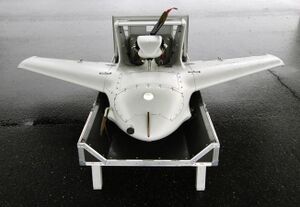Engineering:DRS RQ-15 Neptune
The DRS RQ-15 Neptune is a reconnaissance UAV developed in the United States in the early years of the 21st century. The design is optimized for operations over water, and is capable of water landings on its flying boat–like hull. The 11.2 kW (15 hp) pusher engine is mounted high to keep it dry during takeoffs and landings. The Neptune can also be launched off a pneumatic catapult and land on a skid. In 2007, one was unsuccessfully launched off the USS Nashville (LPD-13), crashing into the water less than two seconds after lift off.[citation needed]
Specifications
General characteristics
- Crew: None
- Capacity: 20 lb (9 kg) payload
- Length: 6 ft 0 in (1.83 m)
- Wingspan: 7 ft 0 in (2.13 m)
- Gross weight: 80 lb (36 kg)
- Powerplant: 1 × piston engine , 15 hp (11 kW)
Performance
- Maximum speed: 100 mph (160 km/h, 87 kn)
- Endurance: 4 hours
- Service ceiling: 8,000 ft (2,400 m)
Design
The most remarkable design element is the double vertical stabilizer with the piston engine housed inbetween. This arrangement reduces the infrared signature from the side-to-rear view.
References
This article contains material that originally came from the web article Unmanned Aerial Vehicles by Greg Goebel, which exists in the public domain.
- Unmanned Aircraft Systems Roadmap, 2005–2030. Office of the Secretary of Defense. 2005. Section 2 Page 20.
- Manufacturer's website
 |


